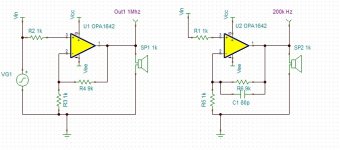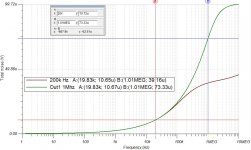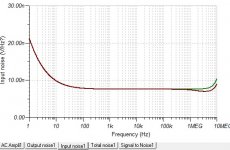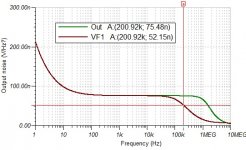When calculating noise, nV/hz * BW^1/2, bandwidth is contributing to noise. so for 2 amplifier, one with 1Mhz bandwidth, another limited to 200k hz, the noise generated by amp is in the chart.
for both configurations, noise at 20k hz is the same 10.7uV,
200khz noise is 34uV (200khz BW), 73uV (1Mhz BW),
as frequency progress, noise level is much higher on the 1Mhz BW amp.
Is the noise above 20khz audible ,
or the noise is only audible under Bandwidth?

for both configurations, noise at 20k hz is the same 10.7uV,
200khz noise is 34uV (200khz BW), 73uV (1Mhz BW),
as frequency progress, noise level is much higher on the 1Mhz BW amp.
Is the noise above 20khz audible ,
or the noise is only audible under Bandwidth?
Attachments
For audio noise measurements, the tradition is to use a 20kHz measurement bandwidth. Of course, out of band noise, if large enough, can cause problems, so it doesn't always have to be ignored simply because it is not audible.
Imagine a shoddy PWM power amplifier that has no output filter. The amplifier will put out a lot of energy above the passband, and this will go directly to the tweeter, heating it up, reducing the safety margin for thermal failure, or causing it to fail when idling. So, sometimes it's important to consider above band noise.
Also, your graph shows the integrated noise magnitude vs. the integrating bandwidth, and it suggests that the 1MHz amplifier gets really nasty above 100kHz. When displaying noise vs frequency, the tradition is to graph the noise density per root Hz, not the integrated total noise from 0Hz to that frequency. Those two amplifiers will probably have overlapping noise density graphs, up to 200kHz, and it'd be easier to see what the amplifier is doing, rather than having to un-integrate the noise from 0Hz on up to the frequency of interest. It also makes displaying low frequency noise a lot easier, since it won't get auto-scaled away from the higher level of integrated HF noise.
Imagine a shoddy PWM power amplifier that has no output filter. The amplifier will put out a lot of energy above the passband, and this will go directly to the tweeter, heating it up, reducing the safety margin for thermal failure, or causing it to fail when idling. So, sometimes it's important to consider above band noise.
Also, your graph shows the integrated noise magnitude vs. the integrating bandwidth, and it suggests that the 1MHz amplifier gets really nasty above 100kHz. When displaying noise vs frequency, the tradition is to graph the noise density per root Hz, not the integrated total noise from 0Hz to that frequency. Those two amplifiers will probably have overlapping noise density graphs, up to 200kHz, and it'd be easier to see what the amplifier is doing, rather than having to un-integrate the noise from 0Hz on up to the frequency of interest. It also makes displaying low frequency noise a lot easier, since it won't get auto-scaled away from the higher level of integrated HF noise.
It's just a simulation chart, so it fits op amp's datasheet quite well with no real environment disturbance. You're spot on, It is much easier to see the effect of BW on noise with the RTO chart. Thank you for the good advice to help me understand the concept better.
What I don't quite understand is the relationship between noise uVrms & frequency. I forgot to tag flat region on the RTO chart which is 76nV/hz, for example when you measure 10khz, there will be 7.6uVrms noise masking 10khz signal, and on 20khz there will be 10.7uVrms noise masking 20khz signal?
or it's just 10.7uVrms over the whole audible bandwidth?
What I don't quite understand is the relationship between noise uVrms & frequency. I forgot to tag flat region on the RTO chart which is 76nV/hz, for example when you measure 10khz, there will be 7.6uVrms noise masking 10khz signal, and on 20khz there will be 10.7uVrms noise masking 20khz signal?
or it's just 10.7uVrms over the whole audible bandwidth?
Attachments
Human hearing upper limit is around 18 kHz (young) or 12 kHz (elder).
Well, I listen to headphone, so I guess I'm in between
I have high frequency hearing loss, because it happens slowly over time you're not aware of it happening and you adapt. I recently got some digital hearing aids which compensate but they've taken a lot of getting used to due to everything sounding tinny. They help with TV and speech but are useless with music due to the delay at high frequencies which cause distortion. I listen to my hi-fi without them but turn the treble up.
What I don't quite understand is the relationship between noise uVrms & frequency. I forgot to tag flat region on the RTO chart which is 76nV/hz, for example when you measure 10khz, there will be 7.6uVrms noise masking 10khz signal, and on 20khz there will be 10.7uVrms noise masking 20khz signal?
or it's just 10.7uVrms over the whole audible bandwidth?
The original chart shows the total noise vs frequency F. This is what you'd get if you integrated the noise from 0Hz to F. That magnitude is a voltage that would heat up a resistor just the same as a DC voltage of the same magnitude would - it's the total voltage at all frequencies from 0 to F.
A noise signal is a 'density', sort of like a gas, so when you zoom in to a frequency, using narrower and narrower bandwidth, the noise level continues to decrease. It's like driving in fog - at a distance, the fog is thick and you can't see but as you get closer, the total fog decreases and you can see. The density hasn't changed, you're just taking a smaller slice of it.
A non-random signal like a sine wave however does not behave this way - when you zoom in, analyzing a narrower and narrower bandwidth around the signal, the level stays the same. This has the result that an FFT of a random signal will show a level of noise in each bin according to the bandwidth of each FFT bin. So, a 16K point FFT will show a 'noise floor' very different from a 1024K point FFT, even though the signal is the same. Sine waves within that signal however will not change magnitude. This property is very useful when analyzing a signal, as it allows you to 'peel back' random signals and somewhat separate them from deterministic signals.
The original chart shows the total noise vs frequency F. This is what you'd get if you integrated the noise from 0Hz to F. That magnitude is a voltage that would heat up a resistor just the same as a DC voltage of the same magnitude would - it's the total voltage at all frequencies from 0 to F.
I've try to find the answer for quite a while, saw different explanation, you gave the best one. So for the circuit, the noise voltage Rms will still be near 73uV for 1Mhz BW, 34uV for 200kHz BW.
But for human, my ear has Bandwidth is 20k hz , it's like I look into fog with my ear, and only sees less dense fog , so the out of band energy won't hit my ear, but still might affect the circuits.
In a circuit, is it possible for the out of band noise coupled back to audible frequency?
Tinitis causes constant whistling at the damaged frequencies. The brain suppresses this, but it is there if you think about it.Do you test it with pure sine wave or you can identify the missing part in the music? Funny thing about brain is, it'll recall how music sounds like, and fill the details a bit for you. I don't know if that's myth or truth...
I have 14000 hz tested in 2008 by the industrial medical service at the factory. I can hear overtones of the top piano octave, 2217-4186 hz, when the builder allowed them out. Most guys cannot and can be fooled into thinking a ****** studio is a great piano. Bells cymbals celesta and other percussion instruments also are more interesting with the full spectrum.
Hint- wear your earplugs around loud sound sources. I do. Breaking off cilia in the cochlia doesn't hurt, but is permanent. Lost mine in 1969 at Army camp.
As far as out of band sources, intermodulation distortion produces sum and difference frequencies of out of band frequencies. So 20 khz + 25 khz can produce 15 khz noise.
A 14 khz + 20 khz IM test is an interesting number, one that a lot of early amps did not do well. I hear my 1964 design Shober organ amp produce weird whistles & squawks when I play my CD player through it with lots of high freq content.
Last edited:
I have high frequency hearing loss, because it happens slowly over time you're not aware of it happening and you adapt. I recently got some digital hearing aids which compensate but they've taken a lot of getting used to due to everything sounding tinny. They help with TV and speech but are useless with music due to the delay at high frequencies which cause distortion. I listen to my hi-fi without them but turn the treble up.
Is the hearing aid something like adc dsp analog? what causes the delay in hi frequency? maybe you can make one which is hifi enough. just might be big and bulky...
Hint- wear your earplugs around loud sound sources. I do. Breaking off cilia in the cochlia doesn't hurt, but is permanent. Lost mine in 1969 at Army camp.
As far as out of band sources, intermodulation distortion produces sum and difference frequencies of out of band frequencies. So 20 khz + 25 khz can produce 15 khz noise.
In military, the first time I shot a gun, the sound was too loud, and it gave me squeaking sound for 3 days. It was just temporary. I'm careful since then. Now I wear headphone with no music for protection when the environment is too loud or just stuff something in the ear.
IM I remember it's the slew rate too slow within the loop, not caused by large loop gain , my circuit is pretty simple just op + buffer, I came here try to understand some confusing concepts. It looks like most people here are knowledgeable, that's amazing.
I don't know much about tools, are there inexpensive tool to measure noise level down to 10uV or even lower? would a cheap millivolt meter do the job?
Assuming the entire system is perfectly linear you will not hear signals above the hearing range. Non-linearities in some active circuitry can modulate energy down to lower frequencies, so that is something that you might consider.
That's good point. I use op amps + buffer for a small amp and aiming to increase open loop gain of op to maximum , just a simple darlington buffer, but not sure how much non-linearities on the output can be fixed by loop gain. But well it sounds pretty good when it doesn't oscillate
What would be a reasonable SNR level to aim for, when I design a headphone amp or preamp? because on calculation it can look very neat.. But in fact, I feel like reading a book in the darkness.
I don't have any tool to measure noise, I would like to know if there's an inexpensive way to do so.
.... are there inexpensive tool to measure noise level down to 10uV or even lower?....
Audio amplifier. TL072 and similar.
You measure hiss on the *output* of your preamp. So already the 1uV RTI hiss is 10uV or 50uV. That will not read on a milli-Volt scale. Wire a TL072 stage for gain of 100. Now you are up in the milliVolts. The TL072 self-hiss is ~~2uV so will not add hiss to any high-gain preamp.
I have *never* needed to measure hiss exactly. Either the hiss of my circuit is similar to other good circuits, or at least low-enough, or there is A Problem.
Ray Dolby wrote a paper, in the form of a JAES pre-print which pointed to the region of 5 to 7kHz as the area to which the human ear was most noise-sensitive.
They also wrote up a method of measuring noise which accurately reflected the response of the ear/brain. The "average responding meter" was more accurate in correlating to the human experience than RMS, quasi-peak, etc.
I think we have a lot more issues with hum of the 50/60 100/120 Hz variety...
They also wrote up a method of measuring noise which accurately reflected the response of the ear/brain. The "average responding meter" was more accurate in correlating to the human experience than RMS, quasi-peak, etc.
I think we have a lot more issues with hum of the 50/60 100/120 Hz variety...
I don't know much about tools, are there inexpensive tool to measure noise level down to 10uV or even lower? would a cheap millivolt meter do the job?
Make a simple high gain buffer powered from a pair of 9V battery. Use a low noise op-amp like OPA1652 which has super low current density noise and also decent voltage noise. Put it in a metal enclosure for shielding.
Connect it to a half decent line level sound card input on your PC. The motherboard sound input might be okay but some are really poor. You would need to try it. If you have the money, something like Behrigner UCA202 has an okay line input (range up to 22KHz). I use an EMU0404 which has really clean inputs (range up to 96KHz). Now you can see the noise on FFT. If you want to see above 96KHz you will need a 'scope, maybe PicoScope or Analog Discovery.
Make sure you have DC coupling capacitors to protect your sound interface!
Last edited:
In military, the first time I shot a gun, the sound was too loud, and it gave me squeaking sound for 3 days.
We get ear protectors when shooting clays.
I don't know much about tools, are there inexpensive tool to measure noise level down to 10uV or even lower? would a cheap millivolt meter do the job?
There are lots of designs on the web -- me, I have several -- one uses SSM2019 with gain of 100, and noise in the vicinity of 1nV/RtHz.
Because noise is always referenced with respect to bandwidth, if you are going to compare with others you MUST filter the output of the noise amplifier so that you can compare results with others. You can use a 20Hz to 20kHz bandpass filter, 20kHz to 80Hz etc.
- Status
- This old topic is closed. If you want to reopen this topic, contact a moderator using the "Report Post" button.
- Home
- Source & Line
- Analog Line Level
- Is noise audible above 20kHz



